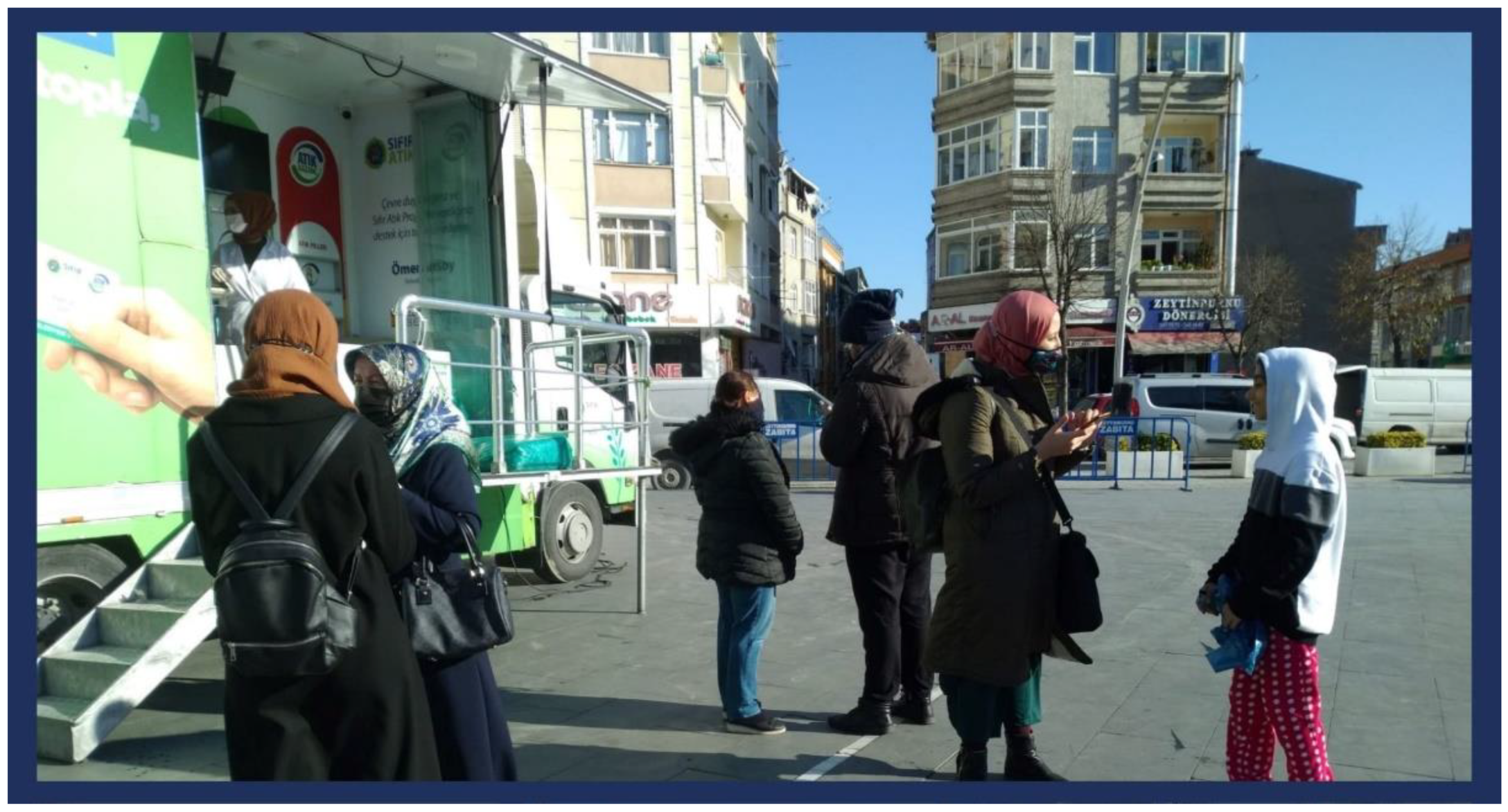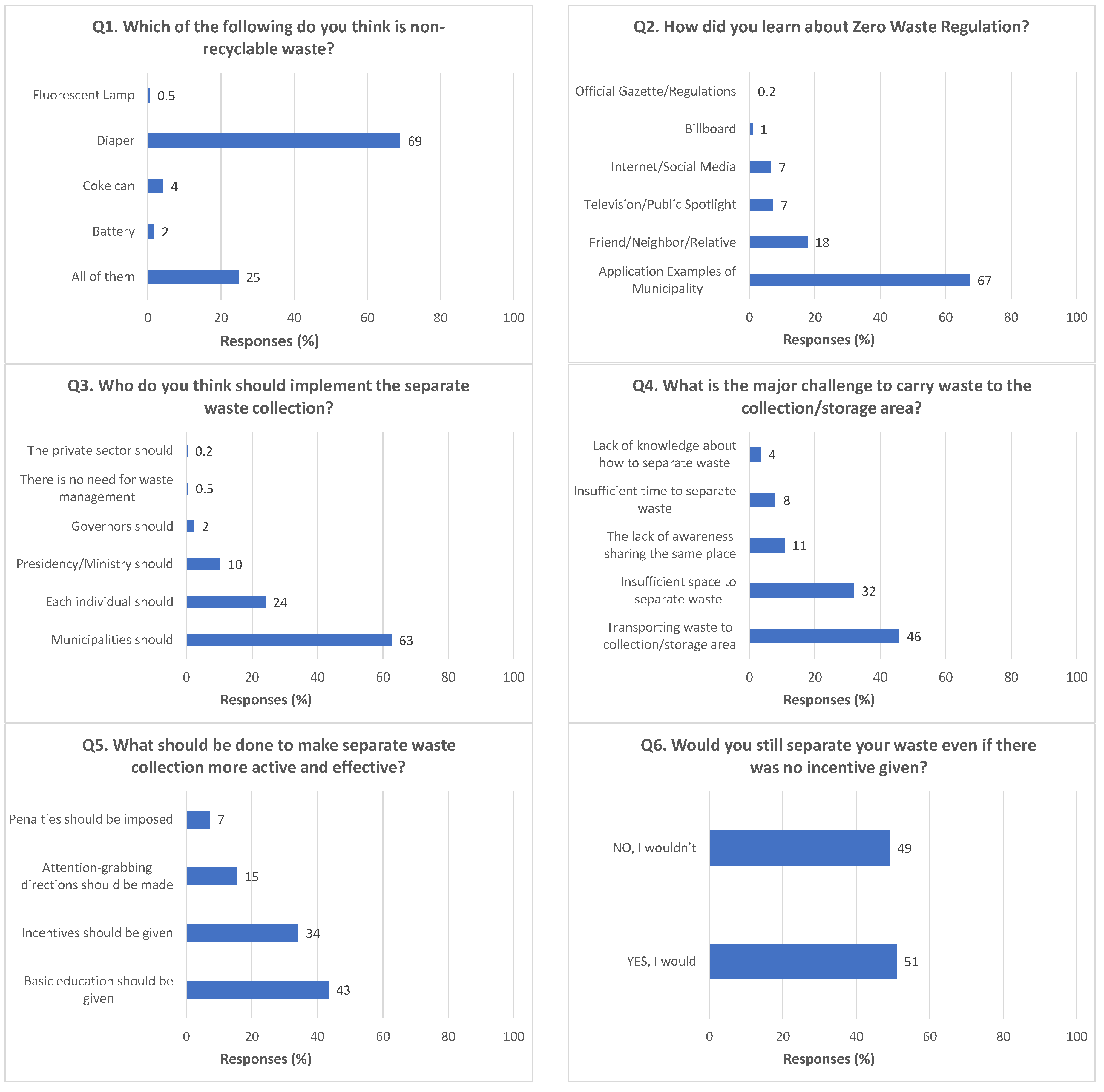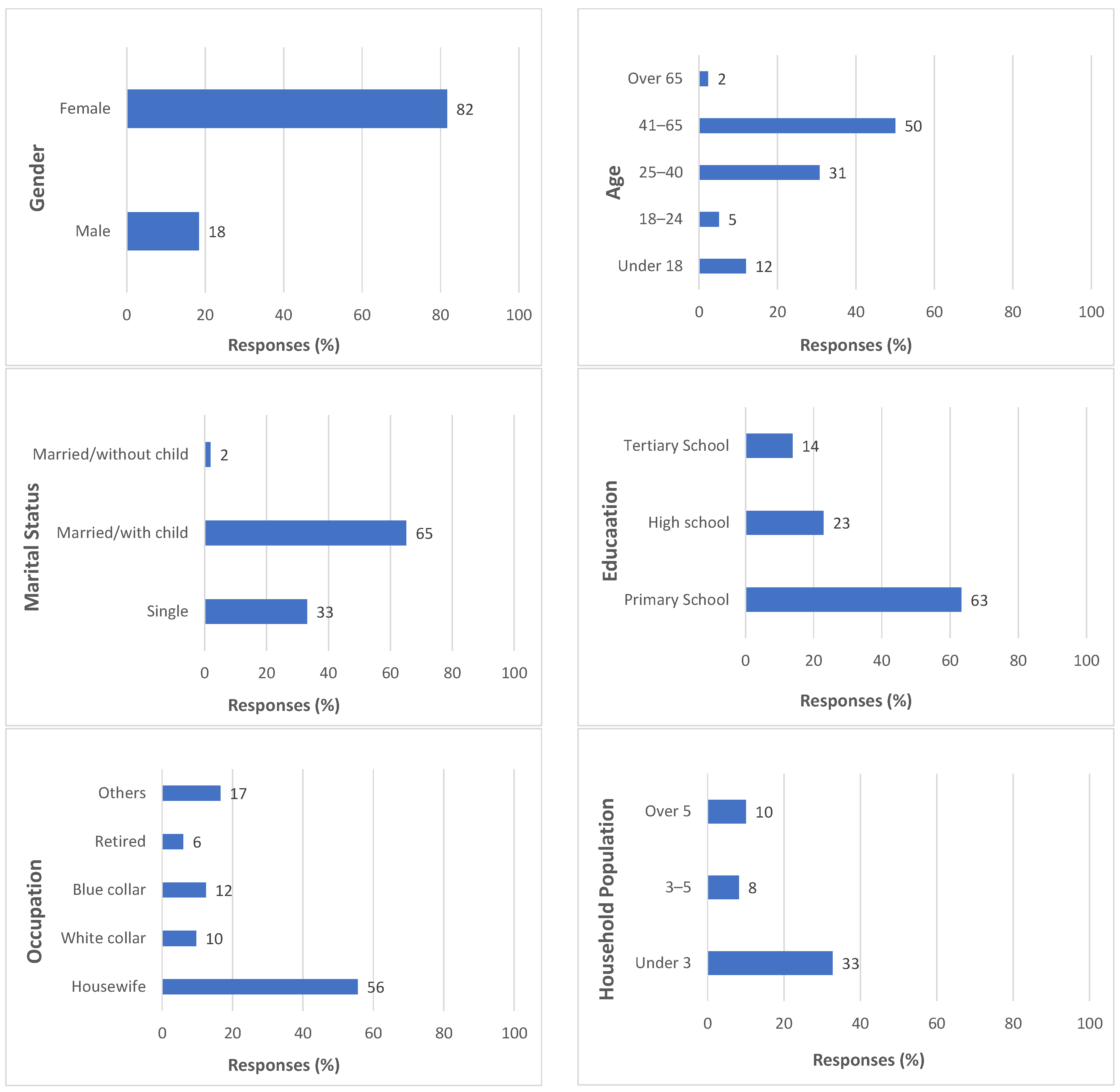The Social Dimensions of an Incentive-Based Urban Recycling Program: A Case-Study from Istanbul, Turkey
Abstract
:1. Introduction
2. Background
3. Case Study: Zeytinburnu Municipality, Istanbul, Turkey
3.1. Zeytinburnu Municipality, Istanbul, Turkey
3.2. Zeytinburnu Waste Recovery Project
4. Research Methodology
4.1. Survey Design
4.2. Demographics of the Survey Population
5. Results and Discussion
5.1. Participants’ Knowledge/Understanding of Recycling/the ZWR
5.2. Participants’ Opinions/Experience Related to Separate Waste Collection
5.3. Pro-Recycling Behavior of the Survey Participants
6. Lessons Learned
7. Conclusions
Author Contributions
Funding
Institutional Review Board Statement
Informed Consent Statement
Data Availability Statement
Acknowledgments
Conflicts of Interest
References
- Espuny, M.; Faria Neto, A.; da Motta Reis, J.S.; dos Santos Neto, S.T.; Nunhes, T.V.; de Oliveira, O.J. Building new paths for responsible solid waste management. Environ. Monit. Assess. 2021, 193, 442. [Google Scholar] [CrossRef] [PubMed]
- Hettiarachchi, H. SDG 11: Challenges and the way forward. In SDG11 Sustainable Cities & Communities: Moving forward with the Circular Economy; Ramani, S., Hettiarachchi, H., Eds.; Routledge: New Delhi, India, 2022; pp. 171–178. [Google Scholar]
- BCG Henderson Institute Cities of Choice: Global City Ranking. Available online: https://web-assets.bcg.com/d0/cf/2204a0c145bd8e7ad591e60152d2/bcg-cities-of-choice-june-2021-v5.pdf (accessed on 15 November 2022).
- Mori Memorial Foundation Global Power City Index 2021. Available online: https://mori-m-foundation.or.jp/pdf/GPCI2020_summary.pdf (accessed on 17 November 2022).
- The Arcadis Sustainable Cities Index 2022. Available online: https://www.arcadis.com/en/knowledge-hub/perspectives/global/sustainable-cities-index (accessed on 26 September 2023).
- Oh, J.; Hettiarachchi, H. Collective Action in Waste Management: A Comparative Study of Recycling and Recovery Initiatives from Brazil, Indonesia, and Nigeria Using the Institutional Analysis and Development Framework. Recycling 2020, 5, 4. [Google Scholar] [CrossRef]
- Castellano, R.; Musella, G.; Punzo, G. The effect of environmental attitudes and policies on separate waste collection: The case of Insular Italy. Lett. Spatial. Resour. Sci. 2019, 12, 63–85. [Google Scholar] [CrossRef]
- Botetzagias, I.; Kevrekidou, M.; Malesios, C.; Jones, N. Exercising social control in PAYT (Pay-As-You-Throw) violations: The role of subjective evaluations and social capital. Waste Manag. 2020, 105, 347–354. [Google Scholar] [CrossRef]
- Stoeva, K.; Alriksson, S. Influence of recycling programmes on waste separation behaviour. Waste Manag. 2017, 68, 732–741. [Google Scholar] [CrossRef]
- Ma, J.; Hipel, K.W. Exploring social dimensions of municipal solid waste management around the globe–A systematic literature review. Waste Manag. 2016, 56, 3–12. [Google Scholar] [CrossRef]
- Knickmeyer, D. Social factors influencing household waste separation: A literature review on good practices to improve the recycling performance of urban areas. J. Clean. Prod. 2020, 245, 118605. [Google Scholar] [CrossRef]
- Miafodzyeva, S.; Brandt, N. Recycling behaviour among householders: Synthesizing determinants via a meta-analysis. Waste Biomass Valorization 2013, 4, 221–235. [Google Scholar] [CrossRef]
- Varotto, A.; Spagnolli, A. Psychological strategies to promote household recycling. A systematic review with meta-analysis of validated field interventions. J. Environ. Psychol. 2017, 51, 168–188. [Google Scholar] [CrossRef]
- Bowles, S.; Polania-Reyes, S. Economic incentives and social preferences: Substitutes or complements? J. Econ. Lit. 2012, 50, 368–425. [Google Scholar] [CrossRef]
- Berger, J.; Efferson, C.; Vogt, S. Tipping pro-environmental norm diffusion at scale: Opportunities and limitations. Behavpublic Policy 2023, 7, 581–606. [Google Scholar] [CrossRef]
- Steg, L.; Vlek, C. Encouraging pro-environmental behaviour: An integrative review and research agenda. J. Environ. Psychol. 2009, 29, 309–317. [Google Scholar] [CrossRef]
- Alexander, C.; Smaje, C.; Timlett, R.; Williams, I. Improving social technologies for recycling. Proc. Inst. Civ. Eng. Waste Resour. Manag. 2009, 162, 15–28. [Google Scholar] [CrossRef]
- Keramitsoglou, K.M.; Tsagarakis, K.P. Public participation in designing a recycling scheme towards maximum public acceptance. Resour. Conserv. Recycl. 2013, 70, 55–67. [Google Scholar] [CrossRef]
- De Feo, G.; De Gisi, S. Public opinion and awareness towards MSW and separate collection programmes: A sociological procedure for selecting areas and citizens with a low level of knowledge. Waste Manag. 2010, 30, 958–976. [Google Scholar] [CrossRef]
- Li, C.J.; Huang, Y.Y.; Harder, M.K. Incentives for food waste diversion: Exploration of a long term successful Chinese city residential scheme. J. Clean. Prod. 2017, 156, 491–499. [Google Scholar] [CrossRef]
- Widdowson, S.J.; Maunder, A.; Ricardo-AEA, A.R. Household Recycling Incentives–Do They Work? In Proceedings of the 20th Waste Conference, Cape Town, South Africa, 6–10 October 2014. [Google Scholar]
- Iyer, E.S.; Kashyap, R.K. Consumer recycling: Role of incentives, information, and social class. J. Consum. Behavior. 2007, 6, 32–47. [Google Scholar] [CrossRef]
- Evans, D. As Cities Shift Strategies, So Does Recyclebank. Available online: https://resource-recycling.com/recycling/2016/10/25/as-cities-shift-strategies-so-does-recyclebank/ (accessed on 10 April 2023).
- United States Government Accountability Office (GAO). USGAO Additional Efforts Could Increase Municipal Recycling. Available online: https://www.gao.gov/products/GAO-07-37 (accessed on 10 April 2023).
- Hettiarachchi, H.; Ryu, S.; Caucci, S.; Silva, R. Municipal Solid Waste Management in Latin America and the Caribbean: Issues and Potential Solutions from the Governance Perspective. Recycling 2018, 3, 19. [Google Scholar] [CrossRef]
- Juárez-Hernández, S. Energy, environmental, resource recovery, and economic dimensions of municipal solid waste management paths in Mexico city. Waste Manag. 2021, 136, 321–336. [Google Scholar] [CrossRef]
- Hettiarachchi, H.; Meegoda, J.N.; Ryu, S. Organic Waste Buyback as a Viable Method to Enhance Sustainable Municipal Solid Waste Management in Developing Countries. Int. J. Environ. Res. Public Health 2018, 15, 2483. [Google Scholar] [CrossRef]
- Elia, V.; Gnoni, M.G.; Tornese, F. Designing Pay-As-You-Throw schemes in municipal waste management services: A holistic approach. Waste Manag. 2015, 44, 188–195. [Google Scholar] [CrossRef] [PubMed]
- Maki, A.; Burns, R.J.; Ha, L.; Rothman, A.J. Paying people to protect the environment: A meta-analysis of financial incentive interventions to promote proenvironmental behaviors. J. Environ. Psychol. 2016, 47, 242–255. [Google Scholar] [CrossRef]
- Abou Taleb, M.; Al Farooque, O. Towards a circular economy for sustainable development: An application of full cost accounting to municipal waste recyclables. J. Clean. Prod. 2021, 280, 124047. [Google Scholar] [CrossRef]
- Vorobeva, D.; Scott, I.J.; Oliveira, T.; Neto, M. Adoption of new household waste management technologies: The role of financial incentives and pro-environmental behavior. J. Clean. Prod. 2022, 362, 132328. [Google Scholar] [CrossRef]
- Morlok, J.; Schoenberger, H.; Styles, D.; Galvez-Martos, J.L.; Zeschmar-Lahl, B. The impact of pay-as-you-throw schemes on municipal solid waste management: The exemplar case of the county of Aschaffenburg, Germany. Resources 2017, 6, 8. [Google Scholar] [CrossRef]
- Yau, Y. Domestic waste recycling, collective action and economic incentive: The case in Hong Kong. Waste Manag. 2010, 30, 2440–2447. [Google Scholar] [CrossRef]
- Timlett, R.E.; Williams, I.D. Public participation and recycling performance in England: A comparison of tools for behavior change. Resour. Conserv. Recycl. 2008, 52, 622–634. [Google Scholar] [CrossRef]
- Bolderdijk, J.W.; Steg, L. Promoting sustainable consumption: The risks of using financial incentives. In Handbook of Research on Sustainable Consumption; Reisch, L.A., Thøgersen, J., Eds.; Edward Elgar Publishing: Cheltenham, UK, 2007; pp. 328–342. [Google Scholar]
- Xu, L.; Zhang, X.; Ling, M. Pro-environmental spillover under environmental appeals and monetary incentives: Evidence from an intervention study on household waste separation. J. Environ. Psychol. 2018, 60, 27–33. [Google Scholar] [CrossRef]
- Truelove, H.B.; Carrico, A.R.; Weber, E.U.; Raimi, K.T.; Vandenbergh, M.P. Positive and negative spillover of pro-environmental behavior: An integrative review and theoretical framework. Glob. Environ. Chang. 2014, 29, 127–138. [Google Scholar] [CrossRef]
- Diekmann, A.; Preisendörfer, P. Green and greenback: The behavioral effects of environmental attitudes in low-cost and high-cost situations. Ration Soc. 2003, 15, 441–472. [Google Scholar] [CrossRef]
- Yalcinkaya, S.; Uzer, S. A GIS-based multi-criteria decision support model for planning municipal solid waste collection points: A case study of Çağdaş Neighbourhood, Çiğli District, Izmir, Turkey. Waste Manag. Res. 2022, 40, 1297–1310. [Google Scholar] [CrossRef] [PubMed]
- Gursoy-Haksevenler, B.H.; Kavak, F.F.; Akpinar, A. Separate waste collection in higher education institutions with its technical and social aspects: A case study for a university campus. J. Clean. Prod. 2022, 367, 133022. [Google Scholar] [CrossRef]
- Coskun, S. Zero waste management behavior: Conceptualization, scale development and validation—A case study in Turkey. Sustainability 2022, 14, 12654. [Google Scholar] [CrossRef]
- Ministry of Environment and Urbanization of Turkish Republic. National Waste Management and Action Plan 2016–2023. Available online: https://webdosya.csb.gov.tr/db/cygm/haberler/ulusal_at-k_yonet-m--eylem_plan--20180328154824.pdf (accessed on 21 October 2021).
- Turkish Statistical Institute Waste Statistics. Available online: https://data.tuik.gov.tr/Bulten/Index?p=Atik-Istatistikleri-2020-37198#:~ (accessed on 4 March 2022).
- Ministry of Environment and Urbanization of Turkish Republic. Regulation on Zero Waste Management, 30829/12.07.2019. Available online: https://www.mevzuat.gov.tr/mevzuat?MevzuatNo=32659&MevzuatTur=7&MevzuatTertip=5 (accessed on 1 October 2021).
- Zeytinburnu Municipality Annual Report (2022). Available online: https://zeytinburnu.istanbul/wp-content/uploads/2023/04/2022_faaliyet.pdf (accessed on 4 March 2022).
- Turkish Statistical Institute Address Based Census Data. Available online: https://data.tuik.gov.tr/Search/Search?text=n%C3%BCfus (accessed on 6 March 2023).
- RAOSOFT Sample Size Calculator. Available online: http://www.raosoft.com/samplesize.html (accessed on 10 October 2021).
- Barr, S. Factors influencing environmental attitudes and behaviors. Environ. Behav. 2007, 39, 435–473. [Google Scholar] [CrossRef]
- Gamba, R.J.; Oskamp, S. Factors influencing community residents’ participation in commingled curbside recycling programs. Environ. Behav. 1994, 26, 587–612. [Google Scholar] [CrossRef]
- Saphores, J.D.M.; Ogunseitan, O.A.; Shapiro, A.A. Willingness to engage in a pro-environmental behavior: An analysis of e-waste recycling based on a national survey of US households. Resour. Conserv. Recycl. 2012, 60, 49–63. [Google Scholar] [CrossRef]
- Vicente, P.; Reis, E. Factors influencing households’ participation in recycling. Waste Manag. Resh 2008, 26, 140–146. [Google Scholar] [CrossRef]
- Tsaur, R.C. Analysis of the relationships among motivation to recycle, willingness to recycle, and satisfaction with recovery stations in Taiwan. WSEAS Trans. Environ. Dev. 2014, 10, 26–34. [Google Scholar]
- Fadhullah, W.; Imran, N.I.N.; Ismail, S.N.S.; Jaafar, M.H.; Abdullah, H. Household solid waste management practices and perceptions among residents in the East Coast of Malaysia. BMC Public Health 2022, 22, 1–20. [Google Scholar] [CrossRef]
- Moh, Y. Solid waste management transformation and future challenges of source separation and recycling practice in Malaysia. Resour. Conserv. Recycl. 2017, 116, 1–14. [Google Scholar] [CrossRef]
- Klöckner, C.A.; Oppedal, I.O. General vs. domain specific recycling behavior-Applying a multilevel comprehensive action determination model to recycling in Norwegian student homes. Resour. Conserv. Recycl. 2011, 55, 463–471. [Google Scholar]
- Timlett, R.; Williams, I.D. The ISB model (infrastructure, service, behavior): A tool for waste practitioners. Waste Manag. 2011, 31, 1381–1392. [Google Scholar] [PubMed]
- Sidique, S.F.; Lupi, F.; Joshi, S.V. The effects of behavior and attitudes on drop-off recycling activities. Resour. Conserv. Recycl. 2010, 54, 163–170. [Google Scholar]





| Demographic Information | Number of Responses | Percentage (%) |
|---|---|---|
| Gender | ||
| Male | 77 | 18 |
| Female | 351 | 82 |
| Age | ||
| Under 18 | 53 | 12 |
| 18–24 | 19 | 4 |
| 25–40 | 114 | 27 |
| 41–65 | 231 | 54 |
| Over 65 | 11 | 3 |
| Marital status | ||
| Single | 123 | 29 |
| Married/with child | 298 | 70 |
| Married/without child | 7 | 1 |
| Education | ||
| Primary school | 319 | 74 |
| High school | 72 | 17 |
| Tertiary school | 37 | 9 |
| Occupation | ||
| Housewife | 261 | 61 |
| White collar | 24 | 6 |
| Blue collar | 55 | 13 |
| Number of people living in the same household | ||
| Under 3 | 128 | 30 |
| 3–5 | 192 | 45 |
| Over 5 | 108 | 25 |
| What Is Expected to Be Assessed with This Question Is Given in Parentheses | Number of Responses | Percentage (%) |
|---|---|---|
| 1. Which of the following do you think is non-recyclable waste? (participant’s common sense in recycling) | ||
| Diaper | 295 | 68.93% |
| Coke can | 18 | 4.21% |
| Battery | 7 | 1.64% |
| Fluorescent Lamp | 2 | 0.47% |
| All of them | 106 | 24.77% |
| 2. How did you learn about the Zero Waste Regulation? (means of access to recycling information) | ||
| Application examples of municipality | 288 | 67.29 |
| Friend/neighbor/relative | 76 | 17.76 |
| Television/public spotlight | 31 | 7.24 |
| Internet/social media | 28 | 6.54 |
| Billboard | 4 | 0.93 |
| Official gazette/regulations | 1 | 0.23 |
| 3. Who do you think should implement the separate waste collection? (opinion on who needs to be responsible for recycling) | ||
| Municipalities should | 268 | 62.62 |
| Each individual should | 103 | 24.07 |
| Presidency/ministry should | 44 | 10.28 |
| Governors should | 10 | 2.34 |
| There is no need for waste management | 2 | 0.47 |
| The private sector should | 1 | 0.23 |
| 4. What is the major challenge to carry waste to the collection/storage area? (difficulties they may encounter in participating) | ||
| Transporting waste to the collection/storage area | 196 | 45.79 |
| Insufficient space to separate waste | 137 | 32.01 |
| The lack of awareness sharing the same place | 46 | 10.75 |
| Insufficient time to separate waste | 34 | 7.94 |
| Lack of knowledge about how to separate waste | 15 | 3.50 |
| 5. What should be done to make separate waste collection more active and effective? (how to make recycling more active and effective) | ||
| Basic education should be given | 186 | 43.46 |
| Incentives should be given | 146 | 34.11 |
| Attention-grabbing directions should be made | 66 | 15.42 |
| Penalties should be imposed | 30 | 7.01 |
| 6. Would you still separate your waste even if there was no incentive given? (the relationship between the incentives versus pro-recycling behavior) | ||
| Yes, I would | 218 | 50.93 |
| No, I would not | 210 | 49.07 |
| Demographic Information | Responses from the More-Conscious Group | Responses from the Less-Conscious Group | ||
|---|---|---|---|---|
| N | % | N | % | |
| Participants | 218 | 50.93 | 210 | 49.07 |
| Gender | ||||
| Male | 40 | 51.95 | 37 | 48.05 |
| Female | 178 | 50.71 | 173 | 49.07 |
| Age | ||||
| Under 18 | 26 | 49.06 | 27 | 50.94 |
| 18–24 | 11 | 57.89 | 8 | 42.11 |
| 25–40 | 67 | 58.77 | 47 | 41.23 |
| 41–65 | 109 | 47.19 | 122 | 52.81 |
| Over 65 | 5 | 45.45 | 6 | 54.55 |
| Marital status | ||||
| Single | 72 | 58.54 | 51 | 41.46 |
| Married/with child | 142 | 47.65 | 156 | 52.35 |
| Married/without child | 4 | 57.14 | 3 | 42.86 |
| Education | ||||
| Primary school | 138 | 43.26 | 181 | 56.74 |
| High school | 50 | 69.44 | 22 | 30.56 |
| Tertiary school | 30 | 81.08 | 7 | 18.92 |
| Occupation | ||||
| Housewife | 121 | 46.36 | 140 | 53.64 |
| White collar | 21 | 87.50 | 3 | 12.50 |
| Blue collar | 27 | 49.09 | 28 | 50.91 |
| Retired | 13 | 68.42 | 6 | 31.58 |
| Others | 36 | 52.17 | 33 | 47.83 |
| Number of people living in the same household | ||||
| Under 3 | 140 | 53.85 | 115 | 46.15 |
| 3–5 | 35 | 54.90 | 30 | 45.10 |
| Over 5 | 43 | 39.81 | 65 | 60.19 |
| F | Prob > F | |
|---|---|---|
| Consciousness and gender | 0.04 | 0.8447 |
| Consciousness and education | 16.50 | 0.0000 * |
| Consciousness and marital status | 2.13 | 0.1207 |
| Consciousness and age | 1.17 | 0.3243 |
| Consciousness and household size | 3.62 | 0.0276 * |
| Consciousness and occupation | 4.50 | 0.0014 * |
Disclaimer/Publisher’s Note: The statements, opinions and data contained in all publications are solely those of the individual author(s) and contributor(s) and not of MDPI and/or the editor(s). MDPI and/or the editor(s) disclaim responsibility for any injury to people or property resulting from any ideas, methods, instructions or products referred to in the content. |
© 2023 by the authors. Licensee MDPI, Basel, Switzerland. This article is an open access article distributed under the terms and conditions of the Creative Commons Attribution (CC BY) license (https://creativecommons.org/licenses/by/4.0/).
Share and Cite
Gursoy Haksevenler, B.H.; Akpinar, A.; Hettiarachchi, H. The Social Dimensions of an Incentive-Based Urban Recycling Program: A Case-Study from Istanbul, Turkey. Sustainability 2023, 15, 15775. https://doi.org/10.3390/su152215775
Gursoy Haksevenler BH, Akpinar A, Hettiarachchi H. The Social Dimensions of an Incentive-Based Urban Recycling Program: A Case-Study from Istanbul, Turkey. Sustainability. 2023; 15(22):15775. https://doi.org/10.3390/su152215775
Chicago/Turabian StyleGursoy Haksevenler, Betul Hande, Aydin Akpinar, and Hiroshan Hettiarachchi. 2023. "The Social Dimensions of an Incentive-Based Urban Recycling Program: A Case-Study from Istanbul, Turkey" Sustainability 15, no. 22: 15775. https://doi.org/10.3390/su152215775
APA StyleGursoy Haksevenler, B. H., Akpinar, A., & Hettiarachchi, H. (2023). The Social Dimensions of an Incentive-Based Urban Recycling Program: A Case-Study from Istanbul, Turkey. Sustainability, 15(22), 15775. https://doi.org/10.3390/su152215775







